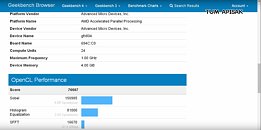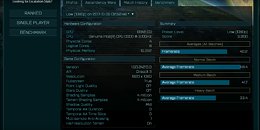Monday, November 6th 2017

Intel, AMD MCM Core i7 Design Specs, Benchmarks Leaked
Following today's surprise announcement of an Intel-AMD collaboration (of which NVIDIA seems to be the only company left in a somewhat more fragile position), there have already been a number of benchmark leaks for the new Intel + AMD devices. While Intel's original announcement was cryptic enough - to be expected, given the nature of the product and the ETA before its arrival to market - some details are already pouring out into the world wide web.
The new Intel products are expected to carry the "Kaby Lake G" codename, where the G goes hand in hand with the much increased graphics power of these solutions compared to other less exotic ones - meaning, not packing AMD Radeon graphics. For now, the known product names point to one Intel Core i7-8705G and Intel Core i7-8809G. Board names for these are 694E:C0 and 694C:C0, respectively.The discrete GPUs on these multi-chip modules (MCMs) are both being reported as packing 24 compute units with a total of 1536 stream processors. Clock rates vary between 1000 MHz and 1190 MHz: the 694E is the lower performance part at 1000 MHz, a 20% reduction from the 1190 MHz for the 694C version (which equates to a graphics performance of around 3.3 TFLOPs, or half that of the much-talked about Xbox One X). Both solutions come with 4 GB of HBM2 memory, and the CPUs are 4-core, 8-thread Kaby Lake parts running at 3.1 GHz and 4.1 GHz Turbo, with the 694C version having its HBM2 memory clocked at 800 MHz versus 700 MHz on the 694E one.
Some benchmarks include GFXBench, where we can see that the Intel Core i7-8809G enjoys an almost 50% performance advantage compared to the Core i7-8705G. This can probably be laid at the feet of the lower GPU core and HBM2 clocks, though it's likely there's some sort of power management features at play here as well - perhaps different TDP configurations, considering the products these SKUs are expected to power? It's also very possible that the Core i7-8705G (694E) features a cut-down version of the AMD GPU as well.Moving on to GeekBench, it seems that the Intel Core i7-8809G is scaling its clocks to stay within its power budget, since the reported max clock speed is now lower - 1 GHz against the 1190 MHz previously seen on GFXBench. Here we have a confirmation of the 24 compute units present on the chip, and see a total OpenCL score of 76,607 points.Next up are some 3D Mark scores and hardware data on the 3D Mark 11 Benchmark (Performance preset), taken from user Tum Apisak's YouTube channel, which shed some more light on the expected performance of the Core i7-8809G compared to the Core i7-8705G, where the former is around 30% better in graphics tests than the latter. However, the fact that the Core i7-8705G just manages to eek-out a win against the Core i7-8809G on the CPU tests (while being virtually trounced on the GPU tests) apparently does confirm the presence of a cut-down GPU. Lower power draw from the GPU likely means that the CPU has more thermal and power headroom to achieve its Turbo clocks for longer, which may help explain the higher CPU score.There's still a benchmark utility to go over; SiSoftware Sandra's, though this one is a mess, likely due to the lack of full support for the parts involved. Average capacity (CUs) for the Core i7-8705G (694E:C0) is reported as both 1403 and the previously known 1536, clockspeeds are now reported as 550 MHz top with an average of 539 MHz, and HBM2 clock is pegged at 500 MHz. This page doesn't really give us much information, and raises more questions than answers, but nevertheless, it's here for your perusal and consideration alongside the other specs and details.Wrapping up, and moving on to a real benchmark, we have the ubiquitous Ashes of the Singularity benchmark rearing its head again. Here, we see the 694E:C0 part, Core i7-8705G's MCM delivering both a 3,900 and 4,800 score (again, power targets and performance profiles playing havoc with the benchmark scores and GPU performance?) Settings were at Low preset, 1080p, where the MCM managed to achieve a 62.9 average framerate on its best run.So there you have it. Performance leaks and benchmarks for the latest "unbelievable" development in out tech industry. Intel and AMD teaming up, in what is an interesting and expected move in a world ruled by reason. Although we really are all forgiven to think, considering our recent experiences, that the world wasn't such a place. All in all, our collective gasp at the Intel-AMD announcement is perfectly understandable. The rumor mill did manage to mill this one out.
Sources:
Tum Apisak's YouTube Channel, Tum Apisak's youTube Channel Video #2, GFXBench, GFXBench
The new Intel products are expected to carry the "Kaby Lake G" codename, where the G goes hand in hand with the much increased graphics power of these solutions compared to other less exotic ones - meaning, not packing AMD Radeon graphics. For now, the known product names point to one Intel Core i7-8705G and Intel Core i7-8809G. Board names for these are 694E:C0 and 694C:C0, respectively.The discrete GPUs on these multi-chip modules (MCMs) are both being reported as packing 24 compute units with a total of 1536 stream processors. Clock rates vary between 1000 MHz and 1190 MHz: the 694E is the lower performance part at 1000 MHz, a 20% reduction from the 1190 MHz for the 694C version (which equates to a graphics performance of around 3.3 TFLOPs, or half that of the much-talked about Xbox One X). Both solutions come with 4 GB of HBM2 memory, and the CPUs are 4-core, 8-thread Kaby Lake parts running at 3.1 GHz and 4.1 GHz Turbo, with the 694C version having its HBM2 memory clocked at 800 MHz versus 700 MHz on the 694E one.
Some benchmarks include GFXBench, where we can see that the Intel Core i7-8809G enjoys an almost 50% performance advantage compared to the Core i7-8705G. This can probably be laid at the feet of the lower GPU core and HBM2 clocks, though it's likely there's some sort of power management features at play here as well - perhaps different TDP configurations, considering the products these SKUs are expected to power? It's also very possible that the Core i7-8705G (694E) features a cut-down version of the AMD GPU as well.Moving on to GeekBench, it seems that the Intel Core i7-8809G is scaling its clocks to stay within its power budget, since the reported max clock speed is now lower - 1 GHz against the 1190 MHz previously seen on GFXBench. Here we have a confirmation of the 24 compute units present on the chip, and see a total OpenCL score of 76,607 points.Next up are some 3D Mark scores and hardware data on the 3D Mark 11 Benchmark (Performance preset), taken from user Tum Apisak's YouTube channel, which shed some more light on the expected performance of the Core i7-8809G compared to the Core i7-8705G, where the former is around 30% better in graphics tests than the latter. However, the fact that the Core i7-8705G just manages to eek-out a win against the Core i7-8809G on the CPU tests (while being virtually trounced on the GPU tests) apparently does confirm the presence of a cut-down GPU. Lower power draw from the GPU likely means that the CPU has more thermal and power headroom to achieve its Turbo clocks for longer, which may help explain the higher CPU score.There's still a benchmark utility to go over; SiSoftware Sandra's, though this one is a mess, likely due to the lack of full support for the parts involved. Average capacity (CUs) for the Core i7-8705G (694E:C0) is reported as both 1403 and the previously known 1536, clockspeeds are now reported as 550 MHz top with an average of 539 MHz, and HBM2 clock is pegged at 500 MHz. This page doesn't really give us much information, and raises more questions than answers, but nevertheless, it's here for your perusal and consideration alongside the other specs and details.Wrapping up, and moving on to a real benchmark, we have the ubiquitous Ashes of the Singularity benchmark rearing its head again. Here, we see the 694E:C0 part, Core i7-8705G's MCM delivering both a 3,900 and 4,800 score (again, power targets and performance profiles playing havoc with the benchmark scores and GPU performance?) Settings were at Low preset, 1080p, where the MCM managed to achieve a 62.9 average framerate on its best run.So there you have it. Performance leaks and benchmarks for the latest "unbelievable" development in out tech industry. Intel and AMD teaming up, in what is an interesting and expected move in a world ruled by reason. Although we really are all forgiven to think, considering our recent experiences, that the world wasn't such a place. All in all, our collective gasp at the Intel-AMD announcement is perfectly understandable. The rumor mill did manage to mill this one out.















48 Comments on Intel, AMD MCM Core i7 Design Specs, Benchmarks Leaked
I'd say it's pretty decent performance for the target market.
Anyone has a 280 and can run a benchie and confirm ? it's just my guestimate of shader vs clock vs tdp.
Wonder what it could do under water....
Looking at the results, it looks close to 1050/Ti depending on the clocks. Will be good for mid range gaming & anything except the oversized desktop replacements that we see advertised with an hour of battery life!
I wonder how things would look like if the MX150 or GTX 1050 were infused there instead. Probably not much different from the stuff we see in ultrabooks anyway
- Motherboard complexity is greatly reduced, saving time and money.
- Power savings by using HBM2.
- Overall area required reduced, allowing smaller designs.
- Cooling complexity reduced immensely, saving money.
And there's more, but those are the big ones.www.3dmark.com/3dm11/11629825
That said, I'm not convinced they put an HBMC/HBCC on Polaris (as some are claiming). I suspect this is a small Vega.
Im just having trouble putting that together...
:D :roll:
Business is business.